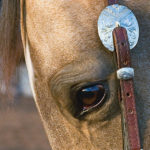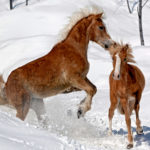 Julie Goodnight demonstrates the one-rein stop on the trail.
Julie Goodnight demonstrates the one-rein stop on the trail.If you don’t know how to stop in an emergency, riding can be a nerve-wracking sport. You wouldn’t drive a car that didn’t have brakes; when you ride, you need to know that you can stop.
Here, top clinician/trainer Julie Goodnight teaches you how to stop your horse in practice sessions so that you’ll know what to do in an emergency. Inevitably, there are spooks and startles out on the trail. When your horse’s flight instinct is triggered, your ride can go from mild to wild in a heartbeat.
To ease your worries and ensure a braking system, Goodnight shows you the one-rein stop for use when your horse gets a little strong or emotional. She also teaches the “if-all-else-fails” pulley-rein stop to use if your horse bolts or runs away with you, or is totally out of control.
Whenever you ask for a stop, use your seat aids first. Otherwise, you teach your horse that you’ll pull on his mouth constantly. Teach him to stop with your seat cues, without any rein aids at all.
In her everyday riding, Goodnight teaches her horses to stop when she exhales and says “whoa.” Then she shifts her weight back. She picks up the reins only as a last resort. “No horse in the world wants his mouth pulled on, and he’s usually happy to stop, so if he gets a cue before the rein contact, he’ll usually obey,” notes Goodnight.
The following techniques are to be used for emergency purposes only.
What you’ll need: Your saddled horse and 9- or 10-foot, single-loop rope reins that are easy to collect and handle.
Skills your horse will need: Your horse should accept a rider, and respond to a voice and rein cue to whoa.
Teach the One-Rein Stop
If you pull on two reins to stop your horse, the pressure on his mouth will be so great that he’ll lean into the pressure and brace against it. The pressure from two reins hurts. The result is a horse that pulls the reins out of your hands and doesn’t listen to your stop cue.
A horse stopped with two reins’ worth of pressure at once (even and most often with a snaffle bit in place) learns to pull, travel with his head held high, and hollow his back. He’ll often develop strong muscles on his neck’s underside.
What’s worse, Goodnight says she often sees riders who pull again and again with more and more pressure when a horse doesn’t stop right away. A horse’s natural reaction to pain and discomfort is to run away from it. So, horses can learn to speed up instead of slow down when the rider thinks she’s telling the horse to stop. The result is a battle of constant pulling.
 Photo 1A: Teach the One-Rein Stop
Photo 1A: Teach the One-Rein StopYou won’t win in this tug of war with your horse. His weight will allow him to win, and he won’t listen to your two-handed stop cue.
The good news is that it’s easy to teach your horse not to force against your rein aids by teaching him to give to one hand and one side — this is called the one-rein stop.
When you want to slow down or stop your horse without a bracey response, simply lift one rein up and diagonally toward your belly button (Photo 1A). At the same time, shift your weight back in the saddle.
Your sequence of cues will turn your horse’s head to the side and cause his hip to disengage from forward impulsion. Simply put, he’ll cross his back legs and lose his forward momentum (Photo 1B).
Disengaging the hindquarters not only stops your horse’s speed and helps him listen to you, but also puts him in a submissive state of mind. When you perform this maneuver, ask a friend watch your horse’s movements from the ground to make sure he’s crossing his legs, with the inside hind leg crossing in front.
To make sure your horse knows to stop (not just turn) with this cue, drop your hand dramatically the instant you feel his momentum slow. Drop your rein to his neck so he gets a clear and meaningful release from the cue.
If your horse doesn’t stop completely, pick up the same rein again and release again when you feel him slow. Do this until he’s totally stopped.
 Photo 1B: Teach the One-Rein Stop
Photo 1B: Teach the One-Rein StopTeaching the release from the cue will help your horse understand your stop cue. If you need to use this cue in an emergency setting, he’ll know what to do and how to receive a release from the rein pressure.
It’s critical to release your horse when he first makes an effort to slow down and stop; he’ll often stop on the release rather than the pull. Timing is everything. The sooner you provide a release for your horse’s willingness to slow and stop, the sooner he’ll understand what to do and learn to follow directions.
At first, you may end up in a full turn as your horse disengages and stops. However, as you work on releasing the rein pressure at the right time, he’ll soon learn to stop on the straightaway when you slightly lift one rein. As you practice, alternate right and left reins so he stops off either.
Your horse usually wants to stop; he just doesn’t always understand what to do and what your cues mean. By using only one rein and teaching him to stop with your release of pressure, he’ll understand and obey quickly.
Teach the Pulley-Rein Stop
If you execute the pulley rein correctly, you can stop a runaway horse immediately. While this riding skill isn’t for everyday use, the move can be lifesaving if your horse bolts, because you’re intentionally applying leverage to his mouth,
 Photo 2A: Teach the Pulley-Rein Stop
Photo 2A: Teach the Pulley-Rein StopGoodnight notes that stopping with the pulley rein is far preferable to pulling an out-of-control horse into a circle with the one-rein stop. If your horse’s flight instinct is fully engaged, turning him sharply or cueing him for a one-rein stop may cause him to lose his footing and fall down. This is most dangerous for the horse and rider’s safety.
The pulley-rein technique requires some practice. This can be risky and hard on your horse. In fact, many instructors don’t like to teach this emergency-stop technique, especially with school horses that may have to endure practice over and over.
Keep your practice sessions short, or consider practicing the rein movements without pulling dramatically.
When you execute this rein-aid correctly, the stopping power is huge — make sure you release your horse the instant he stops. If he begins backing up and you fail to release the pressure, you could be in danger of pulling him over backward onto you. However, used correctly, it’s a great tool to have in your repertoire.
 Photo 2B: Teach the Pulley-Rein Stop
Photo 2B: Teach the Pulley-Rein StopTo practice the pulley-rein stop, shorten one rein as tight as you can, and push that hand’s knuckles into your horse’s neck (as Goodnight demonstrates with her left hand in Photo 2A). Your hand should be braced and centered, with the rein very tight to prevent your horse’s head from turning. This hand is the base of your “pulley,” so keep it pressed into his neck; don’t lift up as you pull back with the other rein.
Next, slide your other hand down the opposite rein, reaching as far forward as you can. It helps to hold the tail of this rein with the fingers that are braced into your horse’s neck. Now, pull straight back and up toward your belly button with all your weight as you sit back into the saddle (Photo 1B).
Because the first rein is locked tight and braced, it prevents your horse’s head from turning; he’s suddenly pulling against his own neck. The pull on the second rein creates a lot of pressure and causes him to stop. You’re using your horse’s weight against him, rather than pulling back on two reins using your own muscle power.
For more information on equine behavior, see Goodnight’s Guide to Great Trail Riding , with bonus DVD, available from www.equinenetworkstore.com.
Julie Goodnight (www.juliegoodnight.com) lives in central Colorado, home to miles of scenic trails. She trains horses and coaches horse owners to be ready for any event, on the trail or in the performance arena. She shares her easy-to-understand lessons on her weekly RFD-TV show, Horse Master, and through appearances at clinics and horse expos held throughout the United States. She’s also the international spokesperson for the Certified Horsemanship Association (www.cha-ahse.org).
Heidi Melocco (www.wholepicture.org) is a lifelong horsewoman, equine journalist, and photographer based in Mead, Colorado.





